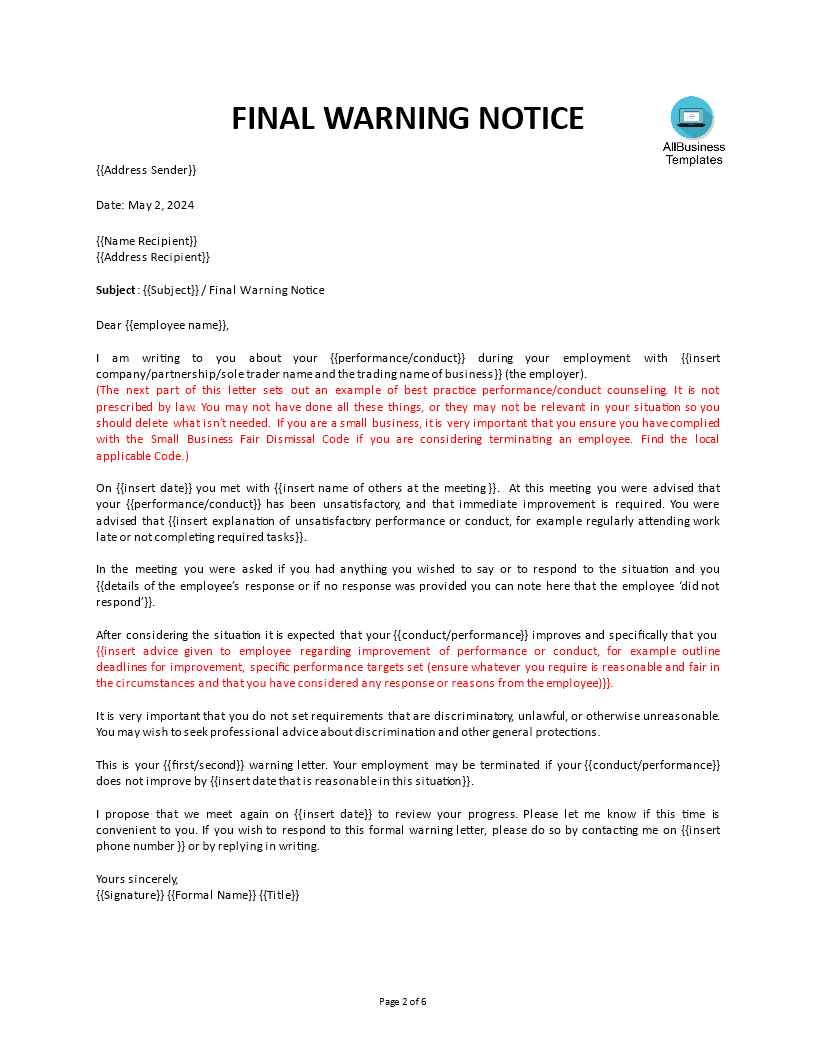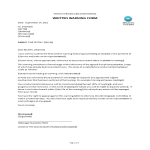Employee Final Warning Letter

Guardar, completar los espacios en blanco, imprimir, listo!
How to write a written warning for low quality of his/her performance? Download this Employee Final Warning Letter template now!
Formatos de archivo disponibles:
.docx- Este documento ha sido certificado por un profesionall
- 100% personalizable
Business Negocio HR RH warning advertencia Letter carta employee empleado letters letras Final Insert Insertar Sample Final Warning Letters Ejemplos de cartas de advertencia finales Final Warning Letter Carta de advertencia final employee final warning template performance improvement warning conduct warning notice last chance warning letter Behavior Warning Letter behavior warning letter template employment final notice hr warning templates poor performance warning job warning notice employee discipline form workplace warning letter final notice before termination employee behavior notice final warning for misconduct warning letter for non performance hr templates for warnings employee warning documentation corrective action notice employment warning letter sample
How to write an effective warning for poor performance to an Employee? Are you tasked with addressing an employee's inadequate work performance within your company?
A written warning is not just a critique—it's also a tool to guide and improve employee performance. Being clear, specific, and supportive can help motivate the employee towards positive changes. Also make sure to add an acknowledgement section on the bottom of the letter. This letter template also includes a Job Abandonment Warning template to address specific instances of absenteeism. These tools are designed to help your business maintain professional standards and support your management practices, ensuring you achieve higher levels of success in your operations.
Common triggers for issuing a warning letter include tardiness, frequent absences, job abandonment, refusal to work, harassment, and disrespectful behavior.
When you are writing a Final warning to employee, for example for poor performance is an important step in the employee management process. It communicates clearly to an employee that their performance is not meeting expectations and outlines the changes they need to make. A professional warning letter is a crucial tool in such situations, outlining that certain behaviors do not align with the company's working environment and cultural expectations, typically documented in the company's code of conduct. A warning letter serves as a formal disciplinary action to inform employees about their infractions and the potential consequences of continued non-compliance. In drafting this letter, it's important to cite specific behaviors, relevant incidents, and the exact dates these violations occurred. The letter should also detail the potential consequences of repeating the same mistakes and what the employee can do to improve.
Here’s how to write an effective written warning for poor performance:
- Start with a clear header: Include the employee's name, the date, and the nature of the document, such as “Written Warning for Poor Peformance”.
- Describe the purpose of the warning: Clearly state that the document is a written warning. This sets the tone and indicates the seriousness of the issue.
- Detail the performance issues: Specify the areas where the employee's performance is lacking. Use specific examples and refer to previous evaluations or incidents. This could include missed deadlines, errors in work, or failure to meet company standards, for example often come too late, or deliver low quality output (mention specific deliverables and costs related bad quality delivered).
- Outline expectations and standards: Clearly describe what is expected from the employee in terms of performance. Be specific about what changes need to be made and what standards must be met moving forward.
- Provide a plan for improvement: Since it's a final warning, you may offer a plan or suggest steps the employee can take to improve their performance. This might include training, regular check-ins, or specific milestones they need to reach.
- Set a timeframe for improvement: Specify a reasonable timeframe in which the employee is expected to improve their performance. This creates a sense of urgency and gives a clear timeline for reassessment.
- Explain the consequences: Clearly state the consequences if the employee fails to improve their performance within the specified timeframe. This could include further disciplinary actions up to and including termination.
- Offer support: Encourage the employee by letting them know that you are available to help them succeed. Mention any resources or support systems the company has that they can utilize.
- Request a follow-up meeting: Schedule a follow-up meeting to discuss progress. This keeps the lines of communication open and shows the employee that you are invested in their improvement.
- Close with signature lines: Include a place for both the employee and a supervisor or HR representative to sign the warning. This acknowledges that the employee has received and understood the warning.
- Keep it professional and respectful: Throughout the letter, maintain a professional tone. While it's important to be clear and direct about the issues, it’s also crucial to be respectful and avoid overly harsh language.
More Tips for Writing an Effective Warning Letter:
- Describe the Violation: State the issue factually.
- Specify Time and Date: Clearly mention when the incident occurred.
- Outline Possible Consequences: Explain the implications of repeated misconduct.
- Reinforce Obligations: Remind the employee of their responsibilities.
- Reference Company Policies: Cite the specific company policy or code of conduct that was violated.
- Offer Solutions for Improvement: Suggest actions the employee can take to rectify the situation.
- Deliver Promptly: Issue the letter as soon after the incident as possible.
- Discuss Personally: Talk to the employee when delivering the warning.
- Maintain Clarity and Consistency: Be clear and consistent in your communication.
Feel free to download and customize this intuitive template, available in several formats, along with other basic or advanced templates and documents on our platform. Simplify your HR processes without reinventing the wheel for each new issue.
Download this Warning Letter for Poor Work Performance template now and streamline your employee discipline procedures!
Also interested in other HR templates? Browse through our database and have instant access to hundreds of free and premium HR documents, HR forms, HR agreements, etc
DESCARGO DE RESPONSABILIDAD
Nada en este sitio se considerará asesoramiento legal y no se establece una relación abogado-cliente.
Deja una respuesta. Si tiene preguntas o comentarios, puede colocarlos a continuación.

